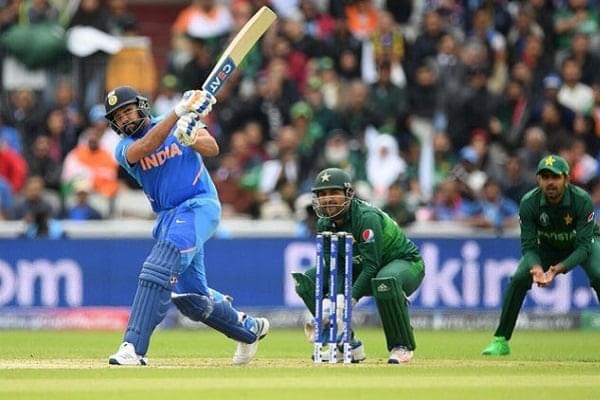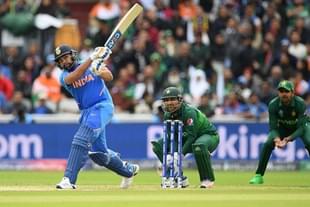Analysis
Thousandth ODI Game: India Will Seek New Energy And Purpose In ODIs Under Rohit Sharma
Karan Kamble
Feb 05, 2022, 05:37 PM | Updated 06:13 PM IST
Save & read from anywhere!
Bookmark stories for easy access on any device or the Swarajya app.


India will play its 1000th one-day international (ODI) game on Sunday (6 February). In doing so, it will become the first team to cross this milestone.
Nearly 48 years have passed since India played its very first ODI match — a 55-over game against England in 1974, where India ended up on the losing side.
Things got better there on after, though ODIs didn’t line up on India’s schedule as quickly as they do these days.
India’s 10th game came four years later, in 1978, against Pakistan. The year that India won the world cup, 1983, was when India jogged to 50 ODI matches, again competing against Pakistan.
Though it was slow-going, the ride picked up pace in the 1980s and thereafter. India went on to play its 500th ODI game in 2002, and on Sunday, 20 years later, it will play its 1000th game. It will be against an inspired West Indies side led by the brilliant Kieron Pollard.
It’s incidental that this landmark game in Indian cricket will also usher a new chapter of Indian limited-overs cricket. A new captain-coach combination is at the helm after dramatic circumstances have unfolded over the last six months.
The new leadership group in the form of Rahul Dravid and Rohit Sharma will now have their sights set firmly on the two upcoming world cups — the Twenty20 (T20) world cup this year and the ODI world cup in 2023. And it appears that winning at least one, if not both, of these tournaments is their chief mandate.
For that to happen, India will have to hit refresh on their approach to the limited-overs formats. A glimpse of the new style of cricket was visible in India’s T20 series against New Zealand last year, soon after India’s shocking exit from the T20 world cup, where the batting group was already seen taking a more positive route in shot-making.
But India’s biggest worry at the moment lies in the ODI game, where a re-think in approach and personnel is essential.
India’s dominant Test match performances over the last two years, in addition to a number of T20 bilateral series wins, has meant that India’s less-than-impressive showing in the ODI format has slipped under the radar.
Every ODI series loss in recent times has seemed like an aberration when it has occurred, but the numbers suggest that a series loss, at least of late, has been more of the norm.
In its last five ODI series, India has emerged victorious only twice. A win percentage of only 40 is surprising for a team made up of players who can easily lay claim to being among the best in the world in the format.

India’s performance has clearly dipped in the 50-over game over a two-year period. But it hasn’t drawn much attention, thanks to some memorable Indian Test match wins both home and away during this same period.
Going back further to assess the five series prior to the latest five, it is seen that an ODI series loss was, at that time, truly an aberration.

The win percentage shoots up to 80 per cent in the period from 2018 to early 2020. The world cup of 2019 clearly splits India’s ODI performances before and after into rise and fall.
One can speculate about the reasons why India hasn’t been faring well in ODIs over the last couple of years.
One is, of course, India’s approach to the game. While teams like England have chosen to step on the accelerator from the get-go, India has adopted a strategy of staying cool and conservative — accumulating runs and keeping sufficient wickets in the bank — before gradually heating up for an explosive last third of the batting innings.
While this approach has worked well over the years, the responsibility has fallen squarely on the shoulders of India’s top three batsmen — Rohit Sharma, Shikhar Dhawan, and Virat Kohli — to mass-produce runs like a factory match after match. When they have perished early, reminding us that they are only human, India has struggled to recover, as is strikingly evident in India’s results in decisive games in the International Cricket Council (ICC) tournaments of the last few years.
Sharma, in particular, has proved to be an essential component of the machine over the years. In fact, the common factor in the last three ODI series losses against South Africa, New Zealand, and Australia has been Sharma’s absence. He also didn’t play the series against Sri Lanka in Sri Lanka, which India won, but it’s fair to say that India would still have fancied its chances against a low-ranked team in the subcontinent without Sharma. And yet, it took a special batting performance by Deepak Chahar to help secure one of two Indian victories to seal the series. (Sri Lanka won the T20 series.)
Between the champions trophy of 2017 and the ICC world cup of 2019, Sharma notched up a 100 every four innings, on average. This high output, paired with a strike rate of over 100 batting in the middle overs — as cricket commentator Harsha Bhogle’s analysis found in 2019 — frequently put India in commanding positions and helped secure series victories.
Since the 2019 world cup, however, Sharma has played only 11 ODIs. That hasn’t helped Team India. Even in this small sample, he registered two centuries, which is the second-most for an Indian batter since then, after Rahul's three centuries in 18 innings.
India’s bowling, too, has been on the wane in the last two years. There was a time when the Yuzvendra Chahal–Kuldeep Yadav spin duo would take heaps of wickets through the middle overs and impede whatever progress the opposition hoped to make going into the back end of the innings. But, of late, India has been unable to take enough wickets or curb runs, beginning, middle, or end.
According to this report, India’s bowling average has been the worst of any ODI team since the 2019 world cup — in fact, India is the only team with a bowling average of over 40. Unfortunately, the economy and strike rates paint exactly the same sorry picture and leave India bottom-placed in these areas as well. There is clearly a need for wicket-taking bowlers and a more attacking approach over the course of the bowling innings — which are recognised as dominant features of India’s Test game.
Many players have spoken about bubble fatigue wearing them down during the Covid-19 pandemic. In response to a question about fatigue, after India’s loss to New Zealand in the recent T20 world cup, ace India fast bowler Jasprit Bumrah said, "Absolutely, sometimes you need a break. You miss your family. You've been on the road for six months.”
During a virtual press conference, then coach Ravi Shastri too flagged the issue and said the players were getting “physically and emotionally drained” staying months in the bio-bubble and away from family for long periods. “I do not care who you are, if your name is Bradman and you are in a bubble, your average will come down because you are human,” Shastri said.
Further, and perhaps most important, it hasn’t helped India’s ODI game when former skipper Kohli has described the format as irrelevant in the absence of an ODI world cup on the horizon in 2020. That was a strange thing to say given that ODI series, though not frequent, were still being written into India’s cricket calendar and every Indian player, and the team, surely only played to win.
Kohli said, after losing the ODI series against the Black Caps in February 2020, “ODIs aren’t too relevant this year compared to Tests and T20s,...”
The comment wasn’t taken favourably by former India captain and batting great Sunil Gavaskar, who said no match played for India can be irrelevant. Former India fast bowler Ashish Nehra also took objection, asking why play ODIs, then, if they are irrelevant?
In a conversation with former Pakistan fast bowler Shoaib Akhtar, Shastri admitted, “One-day cricket khelna padta tha (had to play) because that was on the calendar,” and that red-ball cricket was the “number one cricket” for India over the last five years.
It is this leadership direction that now especially needs to be reversed — as India piles up ODI series losses, especially away — to inspire a turnaround in its limited-overs game. India will need to find new energy and purpose in its ODI pursuits.
For better or for worse, the relevance question doesn’t arise now. India is heading into a T20 world cup this year in Australia and an ODI world cup next year in India. These two formats, regardless of one’s philosophy about them, are going to be as relevant as ever, with India having grown restless without an ICC trophy for many years.
The new skipper, Sharma, is clear he wants to win trophies. “I want to win world cups, that is my dream. I want to win world cups — T20, 50-over, whatever,” Sharma said in an interview with cricket journalist Boria Majumdar in September 2020.
He has also said repeatedly that India should win at least two of the three upcoming world cups (this was said before the T20 world cup of 2021). One tournament down, Sharma now has two world cups left to win glory for India.
The work has begun, with Dravid and Sharma leading from the front in planning the future course. They have even publicly acknowledged and addressed the challenge of physical and mental health.
“I want players to be fresh and switched on and these are challenging times so I would want to work with players and ensure they are well rested,” Dravid said in his first press conference before the T20 series against New Zealand late last year.
And in a break from the recent past, he made it clear that all three formats are equally important to him.
Sharma has spoken about adopting a more fearless brand of cricket, but still one that suits Team India the best. He has emphasised that being two wickets down early shouldn't prevent the Indian middle order from posting a winning total on the board anyway — an area where India has found itself wounded on two to three big occasions.
It’s an exciting new chapter ahead — one that Dravid and Sharma, both greats of the game, would want to write confidently and in such a way that it gives a billion Indians something to rejoice, once again, in the multi-national tournament arena.
Guess it all begins tomorrow, on the occasion of India’s 1000th ODI game. What an iconic day to start writing the next chapter.





